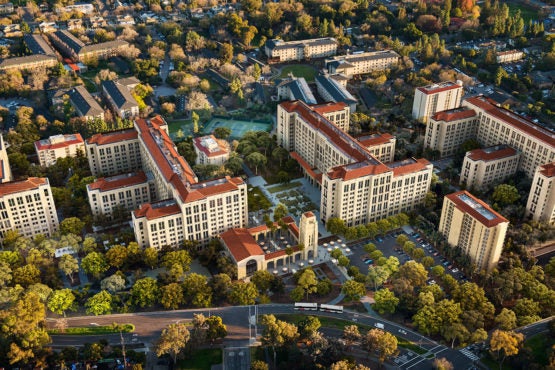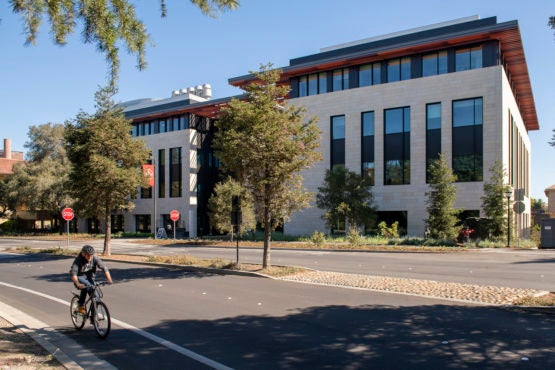Stanford is building for the future
The construction activity around campus is part of the university’s efforts to add on-campus housing and provide academic facilities that foster better research and learning outcomes.
Students, faculty, staff and visitors often ask the question: Why is there so much construction on campus?
The answer, according to university officials: Changes in research and learning, combined with a challenging local housing market, are creating demand for new and updated academic and residential facilities to meet the needs of the Stanford community.

When completed, the Escondido Village Graduate Residences under construction in East Campus (shown in artist’s rendering) will transform the Stanford skyline and allow more than 2,000 additional graduate students to live on campus. (Image credit: Korth Sunseri Hagey Architects)
“The development across campus is designed to provide the physical infrastructure necessary to support a vibrant academic environment and enable emerging fields of study,” said Jack Cleary, associate vice president for Land, Buildings and Real Estate (LBRE). “That includes building new interdisciplinary research labs, classrooms that better engage students and residences for graduate students.”
Projects currently underway range from a renovation of the most prominent outdoor entertainment venue on campus to the university’s largest ever housing development to a new School of Medicine building designed to translate medical research discoveries into treatments and cures.
While the work being done is important for advancing Stanford’s academic mission, university planners acknowledge there are short-term disruptions.
“We spend a lot of time during the planning and design phase anticipating how the construction of a project will impact the campus community and our neighbors, and devising mitigations for those impacts,” said Laura Goldstein, executive director of project management in LBRE. “Before construction, we conduct outreach to affected stakeholders and incorporate their input into our plans whenever possible, and we provide regular updates throughout construction. It is very important to us to maintain a good relationship with the community we serve, and we appreciate everyone’s patience during this period of increased construction activity around campus.”
Below is a description of some of the most prominent projects under construction or recently completed.
East Campus construction
A newly renovated Frost Amphitheater will open in the Arts District in the spring. It will host a variety of events, including a summer symphony series and a performance series featuring popular musicians. Improvements to the space include a new stage, additional restroom facilities and ADA accessibility via a pedestrian tunnel from the Roth Way entrance.
Farther east, the largest campus project is currently underway with the construction of the Escondido Village Graduate Residences (EVGR) that will add 2,020 graduate student beds. Anyone traveling along Campus Drive East between Serra Street and Escondido Road has likely noticed the first of the four 10-story residential buildings taking shape. The buildings are being constructed using precast panels that are manufactured offsite and then transported to campus and assembled onsite, a process that significantly reduces noise and dust. However, precast trucking operations will continue to affect travel along Serra Street and El Camino Real through 2019.
Upon completion of EVGR in fall 2020, roughly 75 percent of graduate students will live on campus, further connecting students to academic life and relieving pressure on the local housing market.
“We’re looking forward to more graduate students being able to live on campus and be more connected to campus life.”
—Laura Goldstein
Executive Director of Project Management, LBRE
“It’s exciting to see the progress being made on EVGR. That whole area of campus is being revitalized as the buildings go up and new bike and pedestrian routes open,” Goldstein said. “We’re looking forward to more graduate students being able to live on campus and be more connected to campus life.”
Stanford is also constructing a three-story underground parking structure with 850 stalls, the Manzanita Field Garage, across Campus Drive East from EVGR to support the project. New playing fields are also being added above the parking structure. The Manzanita Field Garage will open in June 2020.
Closer to the central campus, in the shadow of Hoover Tower, the academic facilities in the Encina Complex are getting an upgrade. The project will create an International Studies hub by removing office space from the back of Encina Commons and adding a courtyard between Encina Hall and a new entrance way from Encina Commons. The Encina Commons lobby will be converted into an activity space, with a bridge across the lobby connecting the two wings of the second floor. Remodeled office spaces, restoration and rehanging of the original chandeliers, and seismic improvements are also part of the project, with a projected completion date of September 2019.
The addition of new facilities in East Campus has also necessitated infrastructure projects to improve the safety and efficiency of travel through the area. Work was recently completed on the fifth traffic roundabout, located at Serra Street and Campus Drive East, and construction is nearing completion on a roundabout at Arboretum Road and Galvez Street, near Stanford Stadium.
Serra Mall, which will soon be renamed, was recently extended to include a portion of Serra Street between Galvez Street and Campus Drive East that is now permanently closed to personal vehicle traffic, becoming primarily a bicycle and pedestrian thoroughfare.
West Campus construction
“Stanford is building major new facilities on the west side of campus that advance the biosciences and human health,” Cleary said. “Faculty, postdocs and students from across the university and around the world will be able to collaborate within these state-of-the-art buildings on research with the potential to significantly improve the human condition.”

The new Anne T. and Robert M. Bass Biology Building will open in January. (Image credit: L.A. Cicero)
The Center for Academic Medicine is going up along Quarry Road at the intersection with Welch Road. When completed, the four-story, 170,000-square-foot building will consolidate office and administrative functions for several Stanford Medicine departments and provide essential support for clinical faculty and educators. The project also includes a three-story underground parking structure with room for 830 vehicles. Construction is scheduled to finish in summer 2020.
A new interdisciplinary research complex is under construction on both sides of Campus Drive West at Via Ortega to house the Wu Tsai Neurosciences Institute and ChEM-H (Chemistry, Engineering & Medicine for Human Health). Both institutes are designed to foster interdisciplinary collaboration among faculty from many different fields. The complex is scheduled to open during summer 2019.
Scheduled to open in the fall of 2019, the School of Medicine’s BioMedical Innovations Building (BMI) will facilitate the translation of medical research breakthroughs into effective therapies. BMI will replace the aging Grant Building within the E. D. Stone Building Complex, with the remaining three buildings slated for future demolition. The four-story BMI Building will include 215,500 square feet of research labs and gathering places designed to encourage collaboration between scientists from a range of disciplines.
The Anne T. and Robert M. Bass Biology Building, located on Campus Drive West near the Oval, will open in January. When finished, the 123,000-square-foot building will provide space for biochemistry and computational research, as well as classrooms and administrative offices for the Department of Biology.
Keeping the community informed and safe
Land, Buildings and Real Estate has created the Heads Up website to inform the campus community and other interested parties about construction activity and provide strategies for safely navigating around campus. Visitors to the website can also sign up for a weekly email with important construction updates and information about potential impacts. Construction-related questions or feedback can be sent to headsup-updates@lists.stanford.edu.
Everyone is advised to take the following steps to stay safe while traveling around campus:
- Look up from your cell phone near construction sites.
- Pay attention to your surroundings as you walk, run, bike or drive.
- Expect detours and follow the directions of the flaggers.
- If you’re riding a bike, follow the rules of the road – stop at signs.
- Allow a little more time than usual to travel on campus.
